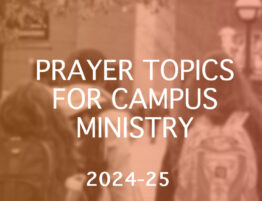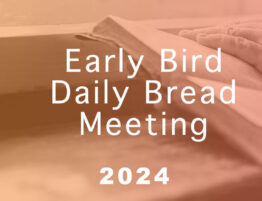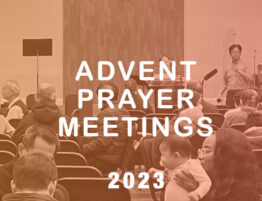January 10, 2023

Young Men’s Bible Study with P. Mark
*MEETING FORMAT: In-Person
*DATE & TIME: Every week: Thursday, 7:30-9:30 PM
*PLACE: Chicago UBF church basement
STUDY QUESTIONS
Lesson 1-John 1:1-6
IN HIM WAS LIFE
John 1:1–5 (Go to ESV Bible Verse)
Key Verse: 1:4
-
How does the author begin, and what does this highlight about Jesus (1–2)?
-
Why does the author call Jesus “the Word” (see verse 18; Heb1:1–3)?
-
What does verse 3 emphasize, and how does knowing this about Jesus affect our worldview?
-
What does “In him was life” mean (4a)? What impact did his life have (4b)? How can we experience his life and light (8:12; 15:5; 20:31)?
-
What statement does the author make, and what does this mean to us (5)?
Lesson 2-John 1:6–13
BELIEVE IN HIS NAME
John 1:6–13 (Go to ESV Bible Verses)
Key Verse: 1:13, “who were born, not of blood nor of the will of the flesh nor of the will of man, but of God.“
-
Who does the author introduce, and what was his purpose (6–8)? What does he say about Jesus (9), and what can we learn from this?
-
When Jesus was in the world, how did people respond to him, and what was wrong with this (10–11)?
-
How did some people respond to Jesus (12), and what does it mean to “receive him”?
-
What does it mean to “become children of God” (13), and how does this happen to us (see 3:3–8)?
Lesson 3-John-1:14-18
THE WORD BECAME FLESH
John 1:14–18 (Go to ESV Bible Verses)
Key Verse: 1:14, “And the Word became flesh and dwelt among us, and we have seen his glory, glory as of the only Son from the Father, full of grace and truth.”
-
What is John’s main point about Jesus (14a)? In light of verses 1–2, what does his becoming flesh mean? Why did he do this (see Heb 2:14–18; Php2:6–8)?
-
What does it mean that he “dwelt among us” (14b; see Mk2:15-17)?
-
What did his followers “see” (14c), and how does this help us understand what “his glory” means? How did his disciples see his glory (2:11)?
-
How did John bear witness about him (15), and why did he say this?
-
What else does the author say about his “grace and truth” (16–17), and what does this mean?
-
What final thing does the author say about Jesus here (18), and what does this mean to us?
Lesson 4-John 1:19-28
THE VOICE
John 1:19–28 (Go to ESV Bible Verses)
Key Verse: 1:23
-
Who came to see John, and why (19; see Lk3:15)? What did he “confess” (20)?
-
What other questions did these people ask (21), and what did these things mean? Why did John’s answers keep getting shorter? What is their final question, and what does it show about them (22)?
-
What did John finally say about himself (23)? Why did he quote this prophecy? What does it mean that he is “the voice”? What does “Make straight the way of the Lord” mean?
-
What further question did they ask, and what does this show about their real intention (24–25)?
-
How did John answer them (26–27), and what does this show about him? What can we learn in this passage about how to be a witness for Jesus?
Lesson 5-John 1:29–34
“BEHOLD, THE LAMB OF GOD!”
John 1:29–34 (Go to ESV Bible Verses)
Key Verse: 1:29, “The next day he saw Jesus coming toward him, and said, “Behold, the Lamb of God, who takes away the sin of the world!”
-
When John first met Jesus, what did he say about him (29), and why was he so excited?
-
How were lambs used during Passover (Ex12:3–13)? How did Jesus fulfill this (Isa53:5–6)?
-
What does the blood of Christ do for us (see Lk22:20; Ro5:9; Heb9:14; 1Pe1:18–19)?
-
What does John repeat (30; see verse 15)? What was the purpose of John’s baptism (31; see also Lk7:29–30)?
-
How did John say he came to know Jesus (32–34)? Why do we need Jesus to baptize us with the Holy Spirit?
Lesson 6-John 1:35-51
“COME AND YOU WILL SEE”
John 1:35–51 (Go to ESV Bible Verses)
Key Verse: 1:39a, “He said to them, “Come and you will see.”
-
What happened the next day (35–36), and why do you think John did this? What did these two disciples do (37), and how was this an act of faith?
-
What did Jesus ask these men (38a), and why? How did they respond (38b), and what does this show about them? What did Jesus say to them, and what did they do (39)? What more can we learn here about faith and discipleship?
-
Who was one of the two disciples, and what did he do (40–42a)? How was this a further act of faith on his part? What did Jesus say to Simon, and why? (42b)
-
Who else did Jesus call to be his disciple (43–44)? What did Philip do and say (45)? Why did Nathaniel hesitate, and how did Philip help him (46)?
-
What did Jesus say to Nathaniel (47)? What else did they say to each other (48–49)? What did Jesus promise him (50–51)? What more does this show about discipleship?
Lesson 7-John 2:1-12
JESUS CHANGES WATER TO WINE
John 2:1–12 (Go to ESV Bible Verses)
Key Verse: 2:11, “This, the first of his signs, Jesus did at Cana in Galilee, and manifested his glory. And his disciples believed in him.”
-
What is the setting (1–2)? What happened (3), and what did this mean in their culture?
-
How did Jesus respond (4), and what did he mean by “my hour” (see 7:4–6)? What did his mother do anyway (5), and what can we learn from her at this event?
-
What details are given, and what was their purpose (6)? What did Jesus tell the servants, and why would this be hard (7a)? What does their response show about them (7b)? What else did Jesus tell them, and what can we learn from them (8)?
-
What did the master of the feast do and say, and what does this tell us (9–10)?
-
How did this sign manifest Jesus’ glory (11), and what does this mean to us (see 2Co5:17)? How did his disciples respond, and what can we learn here?
Lesson 8-John 2:13-22
JESUS CLEARS THE TEMPLE
John 2:13–22 (Go to ESV Bible Verses)
Key Verse: 2:22, “When therefore he was raised from the dead, his disciples remembered that he had said this, and they believed the Scripture and the word that Jesus had spoken.”
-
What is the setting (13)? What did Jesus find, and what was the purpose of these things (14)?
-
What did Jesus do and say (15–16)? How did his disciples respond (17), and what can we learn here about Jesus? Of what is the Jerusalem temple a metaphor?
-
What did the Jews say to Jesus (18), and how did he respond (19)? How was this a prophecy of what would happen (20–21)? In this context, what would the resurrection of Jesus prove?
-
How is the disciples’ response described (22), and what can we learn here about how faith in Jesus grows?
Lesson 9-John 2:23–3:8
YOU MUST BE BORN AGAIN
John 2:23–3:8 (Go to ESV Bible Verses)
Key Verse: 3:3, Jesus answered him, “Truly, truly, I say to you, unless one is born again he cannot see the kingdom of God.”
-
What did Jesus think about those who believed in him based on his signs (2:23–25), and what does this mean?
-
How is Nicodemus described (3:1–2)? What did it mean to be a Pharisee and a ruler of the Jews, and why did he come “by night”? What do you think he was seeking?
-
What did Jesus say to him (3)? What does it mean to “see the kingdom of God”?
-
What does Nicodemus’ response show about him (4)? What did Jesus tell him, and why “born of water” first, and then “the Spirit” (5)?
-
How did Jesus explain what “born of the Spirit” means (6–8), and what can we learn here?
Lesson 10-John 3:9-21
FOR GOD SO LOVED THE WORLD
John 3:9–21 (Go to ESV Bible Verses)
Key Verse: 3:16, “For God so loved the world, that he gave his only Son, that whoever believes in him should not perish but have eternal life.”
-
What was Nicodemus’ question (9), and why was he asking this? What did Jesus say to him (10–12)?
-
What did Jesus say about himself (13)? How did the incident of the bronze snake point to Jesus and God’s promise in him (Nu21:9; 14–15)? What can we learn here about faith?
-
What did Jesus’ being “lifted up” show about God (16; see 12:32–33)? What does it mean to believe and know God’s love (1Jn4:10,12,16)?
-
What else did Jesus say to Nicodemus (17–18), and why do you think he needed to hear this?
-
What were Jesus’ final words to Nicodemus (19–21), and why? What can we learn here?
Lesson 11-John 3:22–36
HE MUST INCREASE, BUT I MUST DECREASE
John 3:22–36 (Go to ESV Bible Verses)
Key Verse: 3:30, “He must increase, but I must decrease.”
-
How is the setting described (22–24)? What does so many people coming to be baptized show about those times
-
What seems to have caused the discussion about purification (25)? What do John’s disciples come and tell him, and what does this show about them (26)?
-
How does John begin his answer, and how does this apply to our lives (27)? Of what does John remind his disciples, and why (28)? What can we learn from his illustration of the bridegroom and his friend (29)?
-
Read verse 30. What did this mean in John’s case? What does it mean to each follower of Jesus? How can we follow this principle in our practical life?
-
How does John compare himself with Jesus (31)? What more does he say about Jesus and those who receive his testimony, and why (32–33)? How does he describe Jesus’ ministry, and what can we learn here (34)? What else is special about Jesus (35)? What is John’s conclusion (36), and what can we learn here about believing?
Lesson 12-John 4:1–30
“I WHO SPEAK TO YOU AM HE”
John 4:1–30 (Go to ESV Bible Verses)
Key Verse: 4:26, “Jesus said to her, “I who speak to you am he.”
-
Why does Jesus leave Judea and head to Galilee (1–3)? How is his route described (4), and what was controversial about this (9b)? Where does he arrive, and how is he described (5–6)?
-
What happens (7a), what is unusual about this, and what does Jesus say (7b)? What other detail does the author add, and why (8)? What does this woman say to Jesus first, and why (9)? How does Jesus answer, and what does he mean (10)?
-
How does the woman respond (11)? What else does she ask, and why (12)? How does Jesus answer, and how do his words speak to her deeper need (13–14)? How does she respond, and what does this show about her (15)?
-
What does Jesus say to her next, and why (16)? How does she respond (17a), what more does he say to her, and what is his purpose in this (17b–18)? What does she say (19), and what else does she mention, and why (20)?
-
What does Jesus teach her about where to worship (21), about the Jews (22), and about how to be a true worshiper (23–24)? What does she say, and what does it show about her (25)? Read verse 26. What do his words mean to this woman, and to us?
-
What happens next (27)? What does the woman do, why, and what impact does it have (28–30)? How is this woman an example for us? In his conversation with this woman, what can we learn from Jesus about how to reach out to people today?
Lesson 13-John 4:31–42
MANY MORE BELIEVED BECAUSE OF HIS WORD
John 4:31–42 (Go to ESV Bible Verses)
Key Verse: 4:41, “And many more believed because of his word.”
-
At this moment, what are the disciples focused on (31–33)? What is Jesus focused on (34)? What does he want his disciples to see, and what does this mean (35)? What does he teach them about the sowers and the reapers, and how does this apply to us (36–38)?
-
How is the faith of the people of Sychar first described, and why does the woman’s testimony have such an impact on them (39)? What do these people do next (40), and what does this show about them, and what can we learn from them?
-
Read verse 41. What is it about Jesus’ words that inspires such faith (3:34; 6:63,68; 7:45–46; cf. Ro10:17)? Ultimately, what does this show about these people (8:47; 10:27)? What important lessons are here for us, both personally and in helping others?
-
What do these people tell the Samaritan woman (42), and how is their conviction related to his vision of the fields white for harvest (35; see also 10:16; 11:51–52)?
Lesson 14-John 4:43–54
THE MAN BELIEVED THE WORD THAT JESUS SPOKE
John 4:43–54 (Go to ESV Bible Verses)
Key Verse: 4:50b, “The man believed the word that Jesus spoke to him and went on his way.“
-
Where does Jesus go (43), how are these people described (44–45), and what does it say about the real meaning of their “welcome” (compare 2:23–25)? How are they a contrast with the Samaritans Jesus had just been with?
-
To what particular place does Jesus go now (46a)? What kind of man comes to him, and what is his request (46b–47)? Locate Capernaum and Cana on a map. What stands out about this man?
-
What does Jesus say to this man first (48), and why? How does the man respond (49), and what does it show about him? What does Jesus tell him (50a), and how is this not what the man expects? Why do you think Jesus sends him away like this?
-
How does the man respond to this (50b)? How would this be hard for him to do, and how is this an example of faith for us?
-
What happens on his way (51), what does he ask (52a), and why? How does his servants’ answer impact him (52b–53)? What does this “sign” (54) mainly show us about Jesus?




